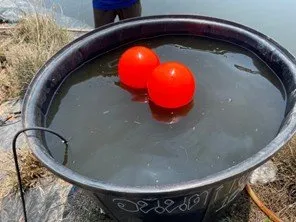Ultramins ‘headline news’ op toonaangevende Aquaculture website IntraFish.
This tech firm is sounding out the salmon sector with a water-purification technique
The cavitating ultrasound technology, already used on Asian shrimp farms, is being tested in Scotland.

After a breakthrough in shrimp, a Netherlands-based water purification startup is attempting to catch the attention of the salmon farming industry by using ultrasound waves to tackle a troublesome microorganism that causes significant losses in smolt.
After several years of success in agriculture, with hundreds of customers in more than 50 countries, the company applied the technology at shrimp farms in Thailand and Indonesia. The latter farm, owned by Hendrikson Shrimping, says it reduced chlorine treatment and extended time before harvesting owing to the improved water quality.

The technology works by creating gas bubbles between water molecules, which then implode in a process called cavitation. The implosion sends a shockwave through the water, which helps eliminate algae, biofilm, fungi, bacteria and other pathogens.
The shockwaves “destroy harmful microorganisms without causing any harm to the shrimp,” Ultramins said in a statement, referring to the implementation of the transmitters at Hendrikson Shrimping’s farms in the Indonesian province of South Sumatra.
Full control
Onno Nienhuis, founder of Hendrikson Shrimping, said in the same statement that, by using the transmitters, his company had so far halved chlorine treatment in its ponds and that he believed a reduction of up to 70 percent is feasible.
“In the past, we sometimes had to harvest early due to disease outbreaks,” said Nienhuis. “Now we have full control.”
Ultramins is also hoping to enter the growing land-based salmon farming sector. The company has received interest from a Norwegian group experiencing challenges with algae build-up in its tanks, van Velzen said.
Under Norway’s animal welfare laws, Ultramins is required to test the potential impact of the technology on salmon prior to deploying it. Those tests will soon begin in Bergen.
Fish, van Velzen explained, can hear only low frequencies and are unaffected by the ultrasound used in the process.
While cavitation has been used in medicine – and even to speed up the ageing of wine – van Velzen said his company is the first to apply the process in aquaculture.
“There is nobody in the world that can compete with us on cavitation technology, using it as we do,” he said. “We are unique.”
Van Velzen said he expects to receive more interest from what he calls “frontier companies” with an eye on both the financials of the technology and its potential for tackling water quality issues without chemicals.
“The people knocking on your doors are the people that are willing to invest in change,” he said.
Link to the website and article:
